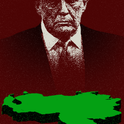I've been writing about two Chinese authors for this month's Prospect, and it just has struck me that Will's June column about "autonyms"—words that in some way embody themselves—touches on something that is fundamental to all languages, but that is far more obvious in character-based ones: all writing has its roots in autonymy. For example, take a few Mandarin Chinese characters:
(Zhong) means "middle," and is based on the image of an arrow striking the centre of a target, and perhaps also the idea of a flag flying
(Guo) means "kingdom," and is based on the image of a square of land within which stands a highly stylized piece of jade, representing the wealth of that land. This is, however, the "simplified" version of the character; the pre-20th century, "traditional" form contains within its outer square the characters representing a town and a weapon, indicating a defended territory.
(Ren) means "person" or "people," and is based on the image of a standing person—one of the most basic and ancient of all characters, and the basis for many other sets of meanings (, for instance, connotes "large," as it represents someone stretching their arms out; while connotes "heaven" because it represents a large man with the sky above him)
Put these together and you have a phrase that reads "middle kingdom people/person," or, as we might more simply put it, "Chinese person/people."
Similarly, in Japanese, take these two characters:
(Ni) meaning "sun" or "day," based on the image of the sun—a circle with a dot in it that has over time become a square with a stroke across its centre. Rather wonderfully, the symbol for the moon is the same but with "legs" drawn in underneath it, , as it has to run faster around the earth.
(Hon) meaning "origin" or "root," based on the image of a tree (, the same as the Chinese character for "large," and with many of its connotations; Japanese writing is derived from Chinese) with the ground drawn in underneath it.
Put them together and you get "sun origin" or, more comprehensibly, "place of the rising sun," which is the Japanese name for Japan (the word "Japan" is a western mangling of Ni-Hon, also pronounced Ni-Pon. The name "China" probably derives from the early Qin dynasty).
Even our own alphabet began with the concrete. The letter "A" can be traced to a pictogram of an ox's head in hieroglyphics; both "C" and "G" probably come from Hebrew representations of a throwing stick; "F" from the image of a hook or club in proto-Semitic; and so on.
There are massive complexities to be explored here which my potted comments barely hint at, but it remains astonishing to think that over the last 6,000 years humanity has leapt from representing the world with images to exploring its deepest workings through the layers of meaning these images have accumulated. No matter how astonishing its flights of abstraction may seem, the written word is rooted in the physical world.
Revisiting autonyms
June 14, 2007












